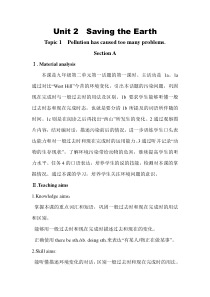 DOC
DOC
【文档说明】《Unit 2 Topic 1 Pollution has causes too many problems》教案2-九年级上册英语仁爱(科普版).doc,共(10)页,52.500 KB,由小喜鸽上传
转载请保留链接:https://www.ichengzhen.cn/view-105101.html
以下为本文档部分文字说明:
Unit2SavingtheEarthTopic1Pollutionhascausedtoomanyproblems.SectionAⅠ.Materialanalysis本课是九年级第二单元第一话题的第一课时。主活动是1a。1a通过对比“WestHill”今昔的环境变化,引出本话题的污
染问题,巩固现在完成时与一般过去时的用法及区别。1b要求学生能够听懂一般过去时态和现在完成时态,也就是要分清1b所提及的词语所伴随的时间。1c则是在阅读之后再找出“西山”所发生的变化。2通过观察图片内容,结对编对话,描述污染前后的情况,进一步训练学生口头表达能力和对一般过去时和现在完成时的运
用能力。3通过听并记录“动物的生存现状”,了解环境污染带给动物的危害,继续提高学生的听力水平。任务4的口语表达,培养学生的说的技能,检测对本课的掌握情况。通过本课的学习,培养学生关注环境问题的意识。Ⅱ.Teachingaims1.Knowled
geaims:掌握本课的重点词汇和短语,巩固一般过去时和现在完成时的用法和区别。能够用一般过去时和现在完成时描述过去和现在的变化。正确使用therebesth./sb.doingsth.来表达“有某人/物正在做某事”
。2.Skillaims:能听懂描述环境变化的对话,区别一般过去时和现在完成时的用法。能理解和运用一般过去时和现在完成时来进行听、说、读、写活动。3.Emotionalaims:(optional)让学生了解环境污染的严重性,并树立
环保意识。4.Cultureawareness:(optional)通过课文的学习,让学生了解环境的变化,关注全球的环境问题。Ⅲ.Thekeypointsanddifficultpoints1.Keypoints:Wordsandphrases:bee,butterfly,mess,sh
ame,several,pollute,waste,villager,destroy,cutdown,goodness,pour,seesb./sth.dosth.,seesb./sth.doingsth.,cutdown,mygoodnessSentences:Whatashame!
/Whatamess!Theflowersandgrasshavegone!Whathashappenedhere?Therebesth./sb.doingsth.Thereareseveralfactoriespouringwastewaterintothestream.Everything
haschanged.Grammar:differencesbetweenSimplePastandPresentPerfecttense.2.Difficultpoints:正确使用therebesth./sb.doingsth.来表达“有某人/物正在做某事”。区
别使用短语seesb./sth.dosth.和seesb./sth.doingsth.。能正确地以口头和书面形式区别使用一般过去时和现在完成时。Ⅳ.Learningstrategies通过引导学生在听前阅读1b和3,培养学生形成听前熟悉、预测听力材料的习惯。通过朗
读1a和2,引导学生模仿已有对话,编写新的对话。通过1c,培养学生整合对话信息,将对话转换为语篇的能力。Ⅴ.Teachingaids图片(关于周边环境变化对比图或者影像资料),录音机,幻灯片等。Ⅵ.TeachingproceduresStep1Review第一步复习(时间:3分钟)观看一段视频
,运用现在完成时态,导入新课。(通过对第一单元的复习,导入被污染的西山景象。)T:Lastunit,wehavelearnedsomechangesinourhometown.Canyousaysome?S1:Ther
oadsarewider.S2:Thebuildingsarehigherandhigher.S3:Thelivingconditionshaveimproved„S4:„T:Yes.Manychangeshavehappenedinourhometown.Let’slook
atthetwopicturesabouttheWestHillanddiscussthechangesbetweenthem.Step2Presentation第二步呈现(时间:15分钟)通过比较1a的两幅图画的差异,展开对话,学习部分生词,呈现1a
。1.(利用幻灯片展示1a中的两幅图,师生问答。)T:Arethereanydifferencesbetweenthem?Ss:Yes.T:Let’slookatPicture1.Whatcanyousee?S1:Icanseesomeflowersandgrass.S2:Icansees
omebutterfliesdancing.T:Yes,therearesomebutterfliesdancing.(板书并要求学生掌握。)thereis/are„doingsth.T:Whatelsecanyousee?S3:Ican
seearabbit.S4:Icanseesomehouses.S5:„T:(指着蜜蜂。)What’sit?Ss:蜜蜂。T:It’sabee.Thereisabeeflying.(板书并要求学生掌握。)beeT:(指着小溪。)What’sit?Ss:小溪。T:It’s
astream.Andtherearesomefishesswimminginthestream.(板书并要求学生掌握。)streamT:WeknowtheWestHillwasabeautifulplace.LookatPicture2.O
h,mygoodness!WhathashappenedtotheWestHill?(板书并要求学生掌握。)mygoodnessS6:Therabbithasdisappeared.S7:Thefishhavedi
ed.S8:Thetreeshavedied.S9:Therearenoflowers,butterflies,grass,andsoon.S10:Therearesomefactories.T:(指着工厂。)Yes,thereareseveralfactorie
s.Theyarechemicalfactories.(板书并要求学生理解。)chemicalT:(指着工厂冒的黑烟,并捂住鼻子做呼吸困难状。)Theyaremakingmuchsmoke.Itcan
causebreathingproblems.(板书并要求学生掌握。)breatheT:(指着排放的废物。)Andtheyarepouringwastewaterintothestream.(板书并要求学生掌握。)wasteT:FromPicture2
,weknowthechemicalfactoriesareharmfultotheanimalsandplants.(板书并要求学生掌握。)Harmfulbeharmfulto2.(要求学生不看书只听录音,捕捉要点,回答问题,提高听力水平。)T
:Closeyourbooks.Listentothetapecarefully,thenanswerthesequestions.(出示小黑板上的问题,听录音1a。)(1)Wherearetheygoingtohavethepicnic?(2)Whydoes
Kangkangsay“Oh,mygoodness!”?3.(核对答案,板书1a的关键词。)beautiful—fresh—clean—gone—dirty—terrible—wastewaterStep3Consolidation第三步巩
固(时间:12分钟)复述1a,引入本课重点,完成1b。1.(要求学生在限定时间内,根据黑板上的关键词复述对话。)T:Trytousethekeywordsontheblackboardtoretell1a.Example:In
thepast,theWestHillwasabeautifulplacewithflowersandgrass.Wecouldseebeesandbutterfliesdancing.Theairw
asfresh,thewaterwasverycleanandwecouldseefishswimming.Butnow,alltheflowers,grass,bees,butterfliesandfishhavegon
e.Thewaterissodirtyanditsmellsterrible.Why?Becausethereareseveralchemicalfactoriespouringwastewaterintothestream.Sowesho
uldprotecttheenvironment.Step4Practice第四步练习(时间:10分钟)通过听力训练,引出污染的概念,充分调动学生的积极性,加深对各种污染及其危害的理解,完成2和3b。1.(播放2录音,学生听后完成2。)T:Weknow,withoutpla
ntsandanimals,theWestHillisn’tbeautiful.Soplantsandanimalsareimportant.Let’slookatthelovelyanimalsinthepicturesin2.Listentothetapeandwrited
ownthenumbersofthecorrectpictures.(若学生没听懂,可再放一遍,核对答案。)2.(学生看图完成3a。)T:Afterlistening,doyouknowwhatdoesgreatharmtoanimals?Ss:Pollution.T:Yes.T
here’remanykindsofpollution.Let’slookatthepicturesin3aandmatchthemwiththephrasesgiven.Trytoguessthemean
ingofsoil.(板书并要求学生理解。)soil(核对答案。)3.(让学生用3a的短语完成3b。)T:Pollutionhascausedmanyproblems.Whatproblemshasitcaused?Pleasecomplete3bwiththe
phrasesin3a.(核对答案,并板书influence,要求学生掌握。)influenceStep5Project第五步综合探究活动(时间:5分钟)通过游戏及调查的方式,加深学生对污染及其危害的印象,增强学生的环保意识。1.Guessinggames.(教师让一学生到讲台,从3a所提供的有
关污染的图片中任取一张,正面面向全体学生,背面面向自己。台下学生描述图片上的内容或引起的污染问题,让台上的学生猜出该种污染的名称。)T:Everyoneofyoucandescribethepicture.Andthestudentinthefrontofthec
lassroomtriestotelluswhatkindofpollutionitis.Example:(S1任意抽取一张图片。)S2:It’sproducedinafactory.(教师帮助学生描述。)S3:Itsmell
sterrible.S4:It’sharmfultoourlungs.S5:It’sblacksmoke.S1:Airpollution.„2.Homework:Makeasurvey.(调查你们家附近的污染状况,并填写表格,以增强学生的环保意识。)T:Nowmakeasurveytos
tudythepollutionaroundyourhome,andfillouttheform.PollutionReasonEffectAirpollutionSoilpollutionWaterpollutionLightpollutionNoisepollut
ionLitterⅦ.BlackboarddesignPollutionhascausedtoomanyproblems.SectionAWordsandphrase:bee,butterfly,mess,shame,several,pollute/pollutionwaste,villager,
destroy,cutdown,goodness,seesb./sth.dosth.,seesb./sth.doingsth.,poursth.into…Sentences:Whatashame!/Whatamess!Theflowersandgrasshavegone!Whathash
appenedhere?Thereareseveralfactoriespouringwastewaterintothestream.Everythinghaschanged.
 辽公网安备 21102102000191号
辽公网安备 21102102000191号
 营业执照
营业执照